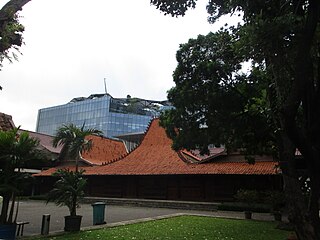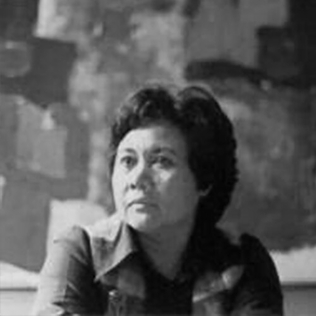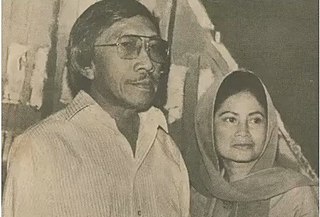
The Merdeka Palace, is one of six presidential palaces in Indonesia. It is located on the north side of the Merdeka Square in Central Jakarta, Indonesia and is used as the official residence of the president of the Republic of Indonesia.

Raden Saleh Sjarif Boestaman was a pioneering Indonesian Romantic painter of Arab-Javanese ethnicity. He was considered to be the first "modern" artist from Indonesia, and his paintings corresponded with nineteenth-century romanticism which was popular in Europe at the time. He also expressed his cultural roots and inventiveness in his work.

The National Museum of Indonesia is an archeological, historical, ethnological, and geographical museum located in Jalan Medan Merdeka Barat, Central Jakarta, right on the west side of Merdeka Square. Popularly known as the Elephant Museum after the elephant statue in its forecourt, its broad collections cover all of Indonesia's territory and almost all of its history. The museum has endeavoured to preserve Indonesia's heritage for two centuries.
Ivan Sagita was born in Malang 1957 and studied at the Indonesian Art Institute in Yogyakarta from 1979 to 1985. He is known as an introvert and mysterious artist, but his work of art is well known in the world of art.

The Jakarta History Museum, also known as Fatahillah Museum or Batavia Museum, is located in the Old Town of Jakarta, Indonesia. The building was built in 1710 as the Stadhuis of Batavia. Jakarta History Museum opened in 1974 and displays objects from the prehistory period of the city region, the founding of Jayakarta in 1527, and the Dutch colonization period from the 16th century until Indonesia's Independence in 1945.

The Indonesia Museum, is an anthropology and ethnological museum located in Taman Mini Indonesia Indah (TMII), Jakarta, Indonesia. The museum is concentrated on arts and cultures of various ethnic groups that inhabit Indonesian archipelago and formed the modern nation of Indonesia. The museum is a richly decorated building in Balinese architecture. The museum boasts a comprehensive collection consisting of over 1,000 pieces of traditional and contemporary Indonesian arts, crafts and traditional costumes from the different regions of the nation.

Ismail Marzuki Park,, is an arts, cultural, and science center located at Cikini in Jakarta, Indonesia. Taman Ismail Marzuki complex comprises a number of facilities including six performing arts theaters, cinemas, exhibition hall, gallery, libraries and an archive building. The complex is built on an 9 hectares land area, which was previously a zoo. TIM is named after Ismail Marzuki, one of Indonesia's most influential composers.

The Arrest of Pangeran Diponegoro is the name of an 1857 painting by Raden Saleh, depicting the capture of Prince Diponegoro by Lieutenant General Hendrik Merkus de Kock on 28 March 1830.

Bentara Budaya Jakarta is a cultural center located on Jalan Palmerah Selatan 17, Central Jakarta, Indonesia. The institution consists of a museum and an art gallery. Open from Monday to Friday at 8 AM to 5 PM, the gallery is closed on weekends and holidays, with an exception being made when special exhibitions are present. Entry to the gallery is free of charge and open to visitors.

The National Museum of Ceramics and Decorative Arts "González Martí", located in Valencia, Spain, is a museum dedicated to ceramics, porcelains and other decorative arts such as textile art, traditional costumes and furniture.

Ceramic art is art made from ceramic materials, including clay. It may take varied forms, including artistic pottery, including tableware, tiles, figurines and other sculpture. As one of the plastic arts, ceramic art is a visual art. While some ceramics are considered fine art, such as pottery or sculpture, most are considered to be decorative, industrial or applied art objects. Ceramic art can be created by one person or by a group, in a pottery or a ceramic factory with a group designing and manufacturing the artware.

Primaya Hospital PGI Cikini, also known as PGI Cikini Hospital or Cikini Hospital, is a hospital in Cikini, Menteng in Jakarta, Indonesia. It was formerly a mansion that was designed by Indonesian painter Raden Saleh, who used it as residence. Use of it as a hospital and nursing academy began in 1898. The building was built in 1852 and is known for its park-like setting in busy Jakarta, and was home to antelope until they were removed in the early 1970s. Saleh once had a collection of wild animals on the property. It has design features similar to the Callenberg Castle.

It is quite difficult to define Indonesian art, since the country is immensely diverse. The sprawling archipelago nation consists of 17.000 islands. Around 922 of those permanently inhabited, by over 1,300 ethnic groups, which speak more than 700 living languages.
Richard Shaw is an American ceramicist and professor known for his trompe-l'œil style. A term often associated with paintings, referring to the illusion that a two-dimensional surface is three-dimensional. In Shaw's work, it refers to his replication of everyday objects in porcelain. He then glazes these components and groups them in unexpected and even jarring combinations. Interested in how objects can reflect a person or identity, Shaw poses questions regarding the relationship between appearances and reality.
The Museum of Modern and Contemporary Art in Nusantara or Museum MACAN is an art museum at Kebon Jeruk in Jakarta, Indonesia. The museum is the first in Indonesia to have a collection of modern and contemporary Indonesian and international art. It has a floor area of 7,107 square meters with display area of about 4,000 square meters. The museum is included in a list of the World’s 100 Greatest Places 2018 released by Time magazine. Museum MACAN opened in November 2017.

Indonesian painting has a very long tradition and history in Indonesian art, though because of the climatic conditions very few early examples survive, Indonesia is home to some of the oldest paintings in the world. The earliest Indonesian paintings were the rock paintings of prehistoric times, such as the petroglyphs found in places like in the caves in the district of Maros in Sulawesi, Indonesia. The Stone Age rock paintings found in Maros Cave are approximately 40,000 years old and are listed as one of the oldest paintings in the world.

Umi Dachlan, born Umajah Dachlan,, was a pioneering Indonesian painter and an art lecturer. She graduated from the Faculty of Fine Arts and Design at the Bandung Institute of Technology ITB in 1968 as the third female graduate, where she also become the first female lecturer. Her work has been described as Abstract expressionism with a figurative Lyricism.

Prof. Emeritus Drs. Abdul Djalil Pirous, known as A.D. Pirous, is an Indonesian fine arts artist and lecturer. He is a pioneer in graphic design education at the Fine Arts Institute of Technology in Bandung, and the founder of an art and design studio called Decenta (1973–1983). A.D. Pirous is married to Erna Garnasih Pirous, and the couple has three children.

Kanjeng Raden Haryo Tumenggung H. Srihadi Soedarsono Adhikoesoemo was an Indonesian painter and tenured lecturer. He married Farida Srihadi, who is also an accomplished painter that studied at the Bandung Institute of Technology (ITB), as well as abroad in the Netherlands and England.

Ahmad Sadali comes from a family with diversified batik and printing businesses. He was an Indonesian painter and art lecturer who is well-known for his abstract art, especially Abstract expressionism, and Cubism and Color field painting. Sadali was among the first and leading students of Ries Mulder, that represented "The Bandung School" of Indonesian art. He is considered one of the most important Indonesian modernist artists, and his works are among the highest priced Indonesian in International art markets. His signature Abstract style expresses elements of nature and spirituality in a bold yet nuanced manner.



















